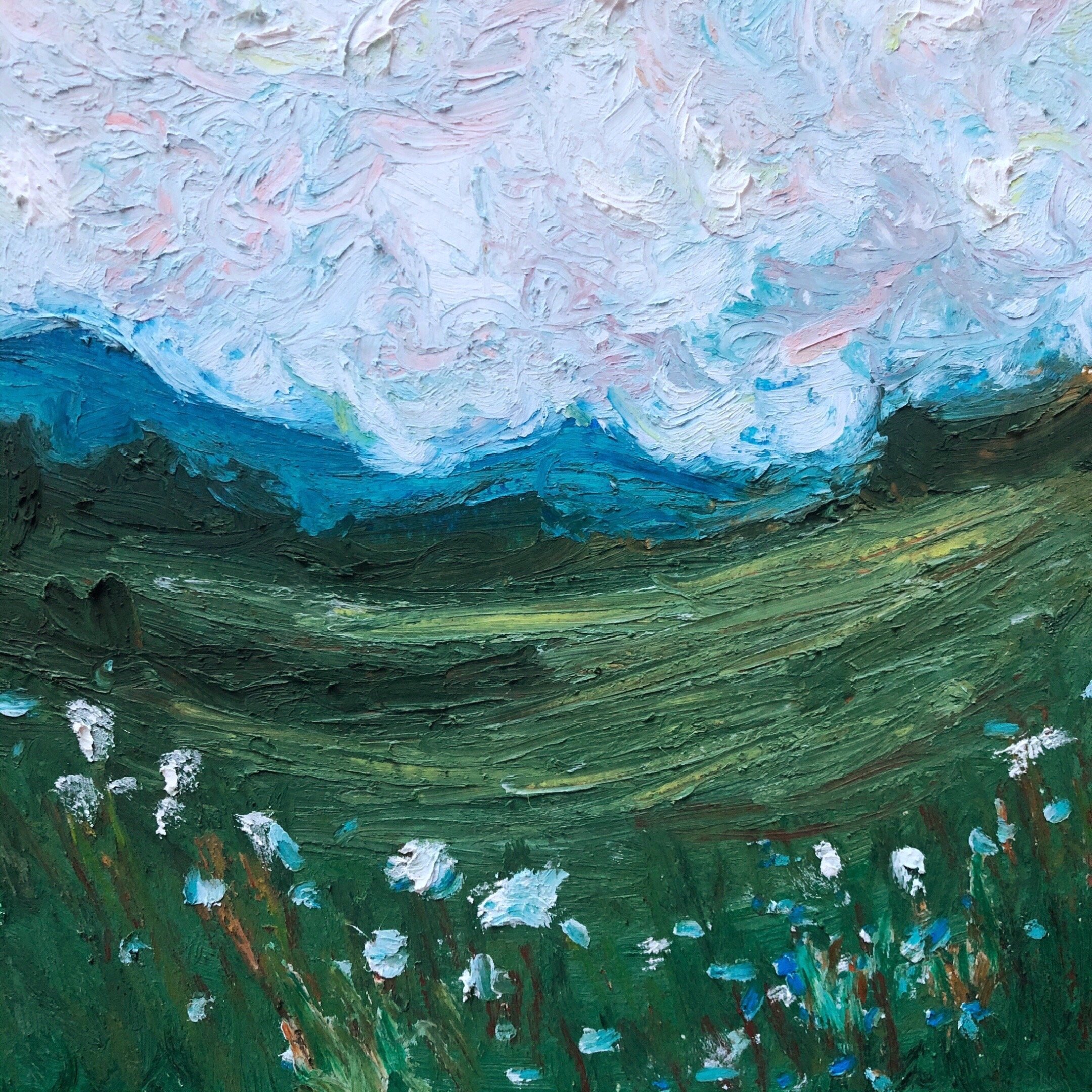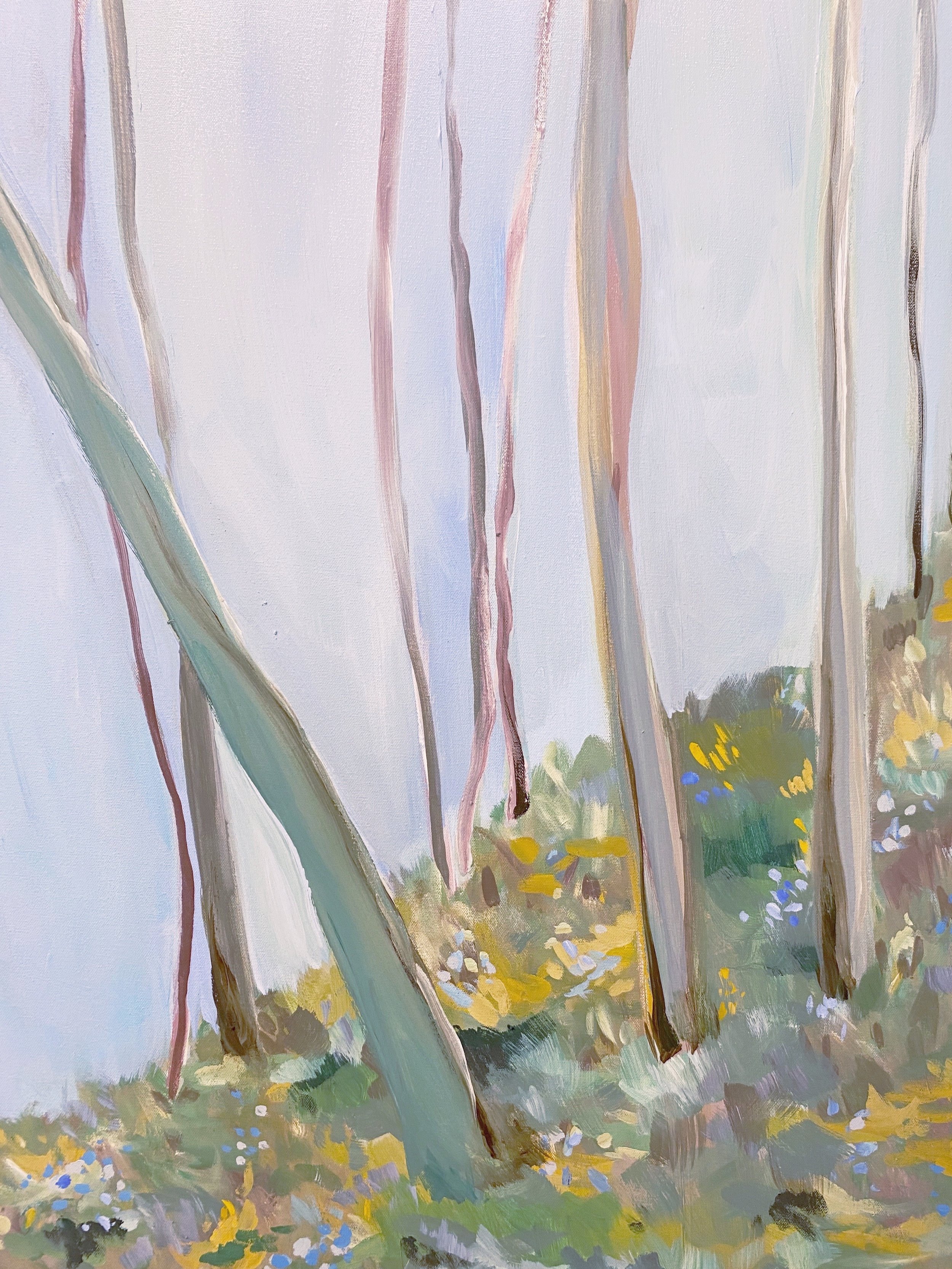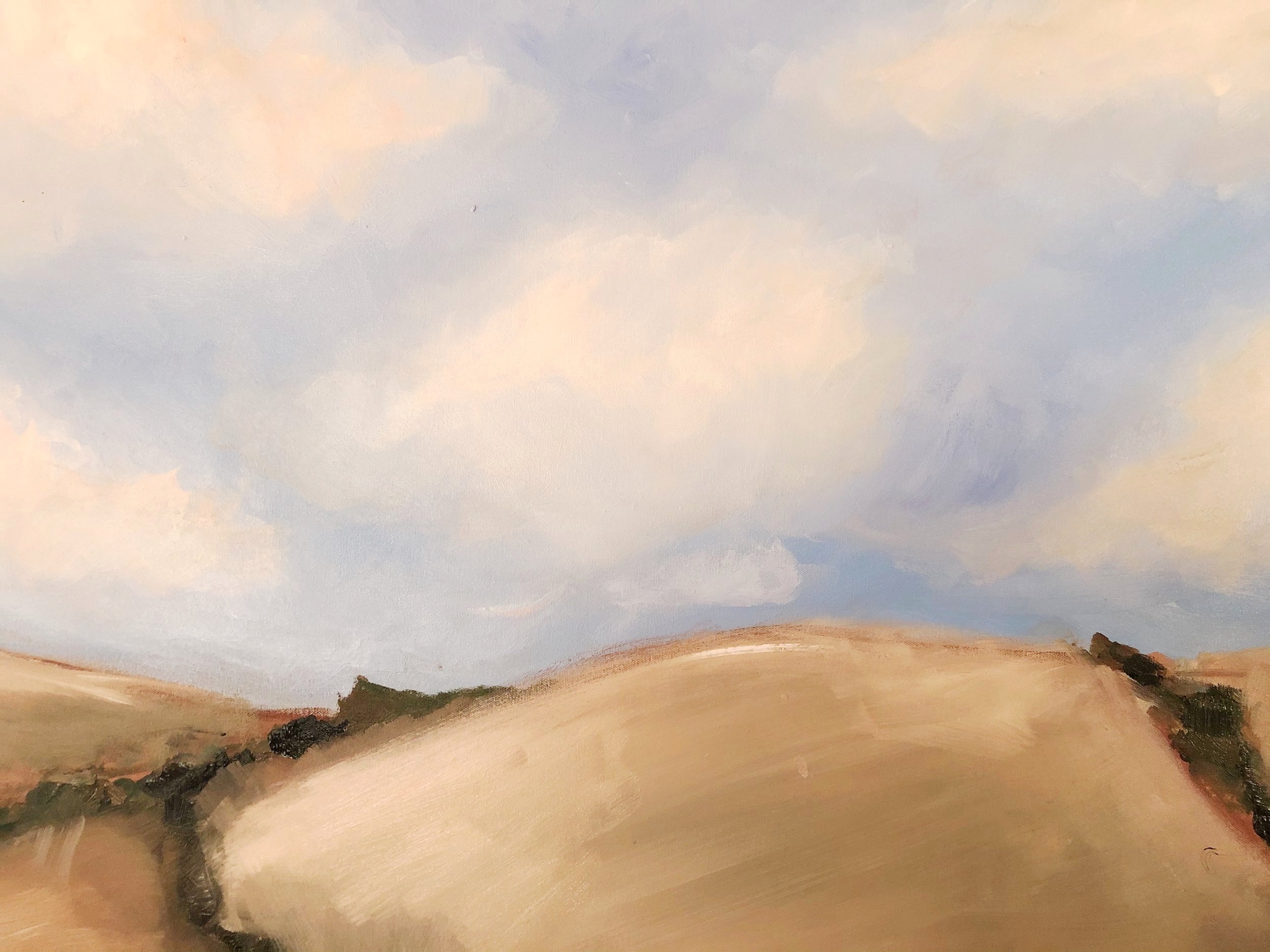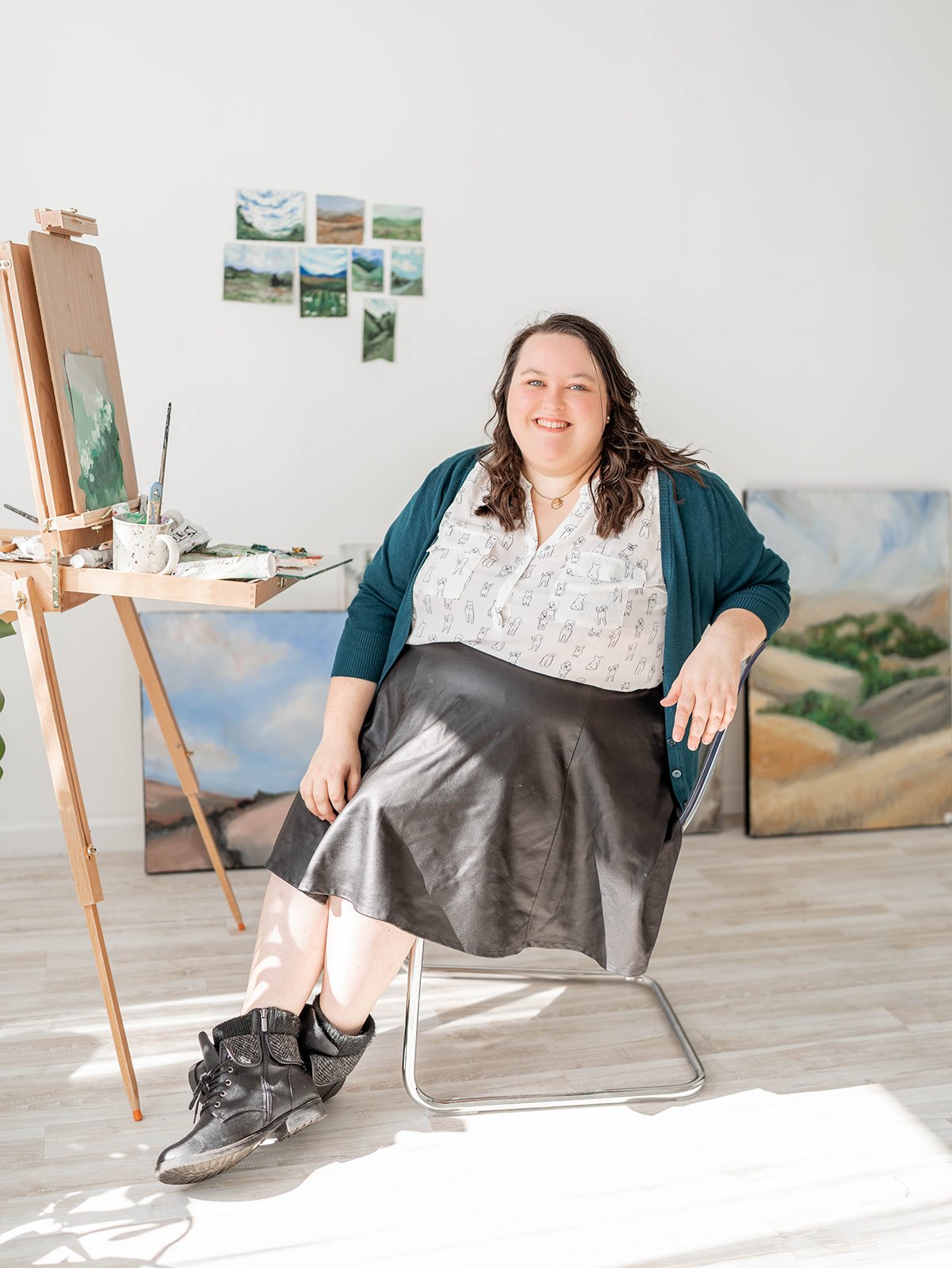Interview
Elizabeth Shanahan
Elizabeth Shanahan was raised in the North Carolina Appalachian foothills, USA, surrounded by the extremes of natural beauty. Such beauty was a fact she was forced to appreciate all the more due to the genetic illness that often leaves her all but immobile. Her disability, combined with indescribably stunning surroundings, led to a fascination with the divinity in the world around us.
Elizabeth’s mixed media paintings strip away the hustle and noise of the modern world, exposing the raw beauty that is essential to our existence. Using a mixture of gestural, abstract mark making, naturalistic painting and drawing, and fresh techniques in mixed media, Elizabeth works with the most natural and universal forms – landscape, water, sky, the human figure and plant life. Her work forces the viewer to pause in the daily struggle to do and be, and confront what is true, essential, and holy.
Elizabeth lives in Lewisville, North Carolina with her husband and daughter. She received her Bachelor of Fine Arts degree from Appalachian State University in 2015. She also studied at the Academia Lorenzo de’ Medici in Florence, Italy, and the Camac Centre d’Art in Marnay-sur-Seine, France. Elizabeth’s work has been exhibited from Florida to New York, and Arizona to Paris.
What is your background and how did you start your journey in the art world?
“I grew up in the rural Appalachian Foothills of North Carolina, where I was constantly surrounded by some of the most breathtaking landscapes you could possibly imagine. That’s where my journey started; from the constant exposure to beauty, and the primal urge to be a part of it and contribute in some way. My parents were initially pretty hesitant about the idea of me pursuing art, and this was understandable given all the stereotypes. Therefore, I pursued a full scholarship for college so that I could get an art degree.
After college, I planned to get a job in a gallery, but there weren’t any jobs in my area at the tail end of the Obama administration. That forced me to start my art business right away and figure it out as quickly as I could. It was really hard, but I’m proud that I was able to stay open and eventually figure out how to make a living.”
What inspires you most?
“To this day, being outside is the biggest source of inspiration for me. I have a genetic disease that can make it hard to access nature the same way I did as a kid. But I’ve always been determined not to let my physical limitations prevent me from being who I want to be, even if it ends up looking different from what I imagined. I use a wheelchair quite a bit, and drive when I can manage. The landscape never disappoints me. It meets me wherever I am.”
“When people look at my work, I want them to feel the same sense of hope, belonging, and overwhelming love that I feel being in nature. This place was made for us, and we for it. I hope that my work makes that beautiful relationship clear.”
What themes do you pursue? Is there an underlying message in your work?
“Growing up in the North Carolina mountains, landscape took on a special meaning for me from an early age. I find God in the ancient slopes of the mountains, in the promise of each changing season, in the soft and quiet waters that determinedly carve their way through rock. My work explores the boundaries between the real and the metaphysical, and the relationship between God, landscape, and humanity.”
How would you describe your work?
“I make neo-impressionist landscape paintings. I primarily paint with a combination of acrylics, earth pigments, and oil pastels. I love what the competing textures can do to create a sense of movement and depth. Raw painting surfaces like oil paper and unprimed canvas are also an important part of my creative process. Different surfaces react with the material differently, drinking it in or letting it build, and I love the flexibility a raw surface gives me to play with that.”
Which artists influence you most?
“The impressionists have always been important for me, especially Paul Cezanne’s ‘Mont Victoire’ series, and Monet’s garden paintings. There’s also a new generation of impressionists that I amm proud to consider myself a member of. Artists like Kacie Landis, Emily Jeffords, Laurie-Anne Gonzales, and Elizabeth Bowman are doing some beautiful things. Their work is clearly influenced by the impressionists of the nineteenth century, but is still totally their own. That innovation with classical subject matter is very exciting for me, and I can’t wait to see what happens with it over the next few years.”
What is your creative process like?
“I’ve always been a one-draft writer, and I treat my art the same way. My paintings typically evolve quickly: from roughly blocking major forms, to color selection, to final details. All this is done on the final piece itself. This means that not every piece works out, but I feel that those pieces that never leave the studio are a vital part of the process for those that do.
I work with a variety of materials and techniques, and you’re just as likely to find me working in oils, oil pastels, or acrylics. I enjoy experimenting with brushes and mixed media, often including elements such as hand stitching, machine embroidery, or gold leaf. My work is frequently mistaken for watercolor because I love to work with watered-down acrylics and raw pigment on wet paper, sometimes layering oil pastel over the top. Conversely, I adore oil pastel for its chunky texture, and would never limit myself to a single type of mark making. All that matters to me is that each material is carefully selected to suit the needs of the piece.”
What’s your favorite artwork and why?
“Is there an artist in the world who can choose a single favorite artwork? It changes daily. If we’re talking about my own work, I’m extremely proud of my ‘Inhale series’, especially a work called ‘The Circle’. It’s very small, only about five inches square, oil pastel on oil paper. I wanted that series to be about restfulness and pauses before exciting things, and I felt like I really achieved the sensation I was looking for in that piece.
In classical art, it’s cliché, but Van Gogh’s ‘Night Café Terrace’ is really important to me. The way every individual stroke is brimming with feeling takes my breath away every time.”
Have you had any noteworthy exhibitions you'd like to share?
“I did a very special project in March of last year where I collaborated with my little sister, choreographer Joy Shanahan, and videographer Matt Sczcygiel to create a dance film with painted backdrops, costumes, and bodies. After we wrapped the project, I presented it at the Stokes County Arts Council with a selection of relevant artworks. I was extremely proud of the exhibition that came out of it. You can see it all here.”
Website: www.elizabethshanahan.com
Instagram: @elizabeth.shanahan







